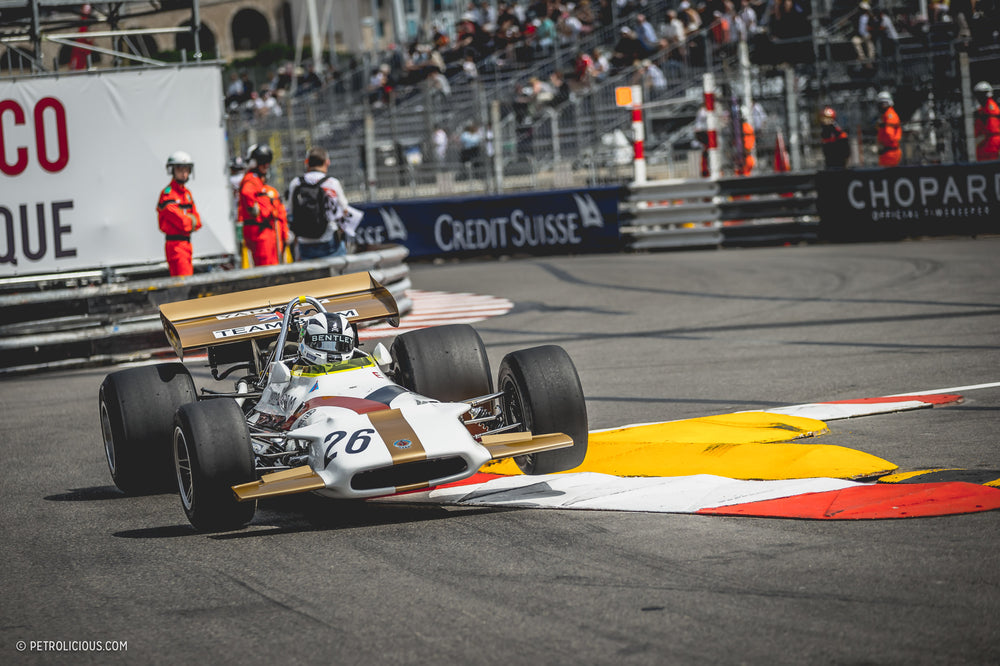The man in the white helmet with the tartan stripe clambers from his racing car, 100 laps and 195 miles have gone by since the race began and out of the 16 cars that started, he is one of just four classified finishers. More importantly than that though, in this extraordinary race of attrition, a young Jackie Stewart has finished first and in doing so has won his first Monaco Grand Prix. The year is 1966, and Formula 1 is changing somewhat. We’ve come a long ways from that point and have changed many more things than engine placement and aero in the time since, and the 2018 Monaco Historique recently brought us back to this earlier shift with its collection cars that took part in the championship between 1966 and 1972.




This period would see the introduction of larger capacity engines again, with three-liter power plants ushered in for 1966. Monaco was the first race in that year’s championship calendar and many teams were not ready for the new regulations. A large number of the group that took to the grid that day ran the previous year’s 1.5-liter versions or had adapted much heavier 3s landed by sports cars. That was not to be the only change in engine design that the Monaco circuit and Formula 1 would see in this era, for the very next year Lotus unveiled the Lotus 49, with its Ford Cosworth DFV engine. The three-liter V8 was both lightweight and low cost, and it would play a crucial role in the sport by allowing constructors to enter the championship at much lower cost than before, while still having a semblance of a chance at winning.







Constructors also started to use aerofoils widely for the first time, although some races would still see the teams strip them from their cars for increased speed on the top end. The experimental nature of these aerodynamic solutions created a wide variety of body shapes for the motorsport fan to gaze upon, and this variety was wonderfully reflected in the entry list for this era at the Monaco Historique. Almost every entrant ran a different car, or version of a car from marques such as Lotus, Ferrari, Brabham, an emerging McLaren, March, Tecno and others. No less than 27 machines took to the streets and almost all were cars from the early ’70s—the racing throughout the field was well matched and frantic. It was fast as well, and watching the stiffly-sprung cars negotiating the tight chicanes of the swimming pool was a particular highlight. No quarter was given as curbs were skipped and tails were hung out, the larger power plants being put to good use as traction was frequently broken at the rear wheels.






The sonic invasion of a field full of V8s was also a noteworthy treat, with the occasional interference of a Ferrari flat-12 breaking through the cadence of the harmonizing DFVs. It was a gloriously entertaining journey to the past, to a time that saw Graham Hill win his last two Monaco Grands Prix at the wheel of his Lotus 49B, and Jochen Rindt achieve his only win at the circuit in 1970. Sadly, this last point is also a reminder of how dangerous motor racing can be as Rindt was killed during practice at Monza later that season, before winning the world championship posthumously.










Monaco also reminded the world what a perilous place she could be, as if anyone had forgotten, when Ferrari driver Lorenzo Bandini lost his life in an awful accident during the 1967 Grand Prix. By the end of the ’60s Armco had been introduced to certain parts of the circuit for the first time and by the end of ’72 the streets that made up the race track were almost completely lined with the safety barriers we are now accustomed to seeing in everywhere in the modern era.





Thankfully, despite a few DNFs throughout the field, the weekends action at the Historique passes safely, with Bjorn Werdheim of Sweden taking the win in his March 711 at the end of the 12 laps. Seeing the different shapes and colors of the cars throughout the different sessions of the event has been a fabulous insight into this particular period of Grand Prix history, one where you can clearly see the sport maturing in the designs that were tested and those that passed and failed such experimentation.


It was a time of advances and changes within the world of Formula 1 as well as for the Monaco Grand Prix itself, as the world pulled out of the swinging sixties and embarked upon a brand-new decade. This class, the “E” grid at the Historique, provides a bridge between the last cigar-shaped cars of the ’50s and ‘60s to the more aerodynamically inclined machines of the latter parts of the ’70s. Vital cars, exhibiting nothing less than pure racing, and an absolute privilege to watch.




























































